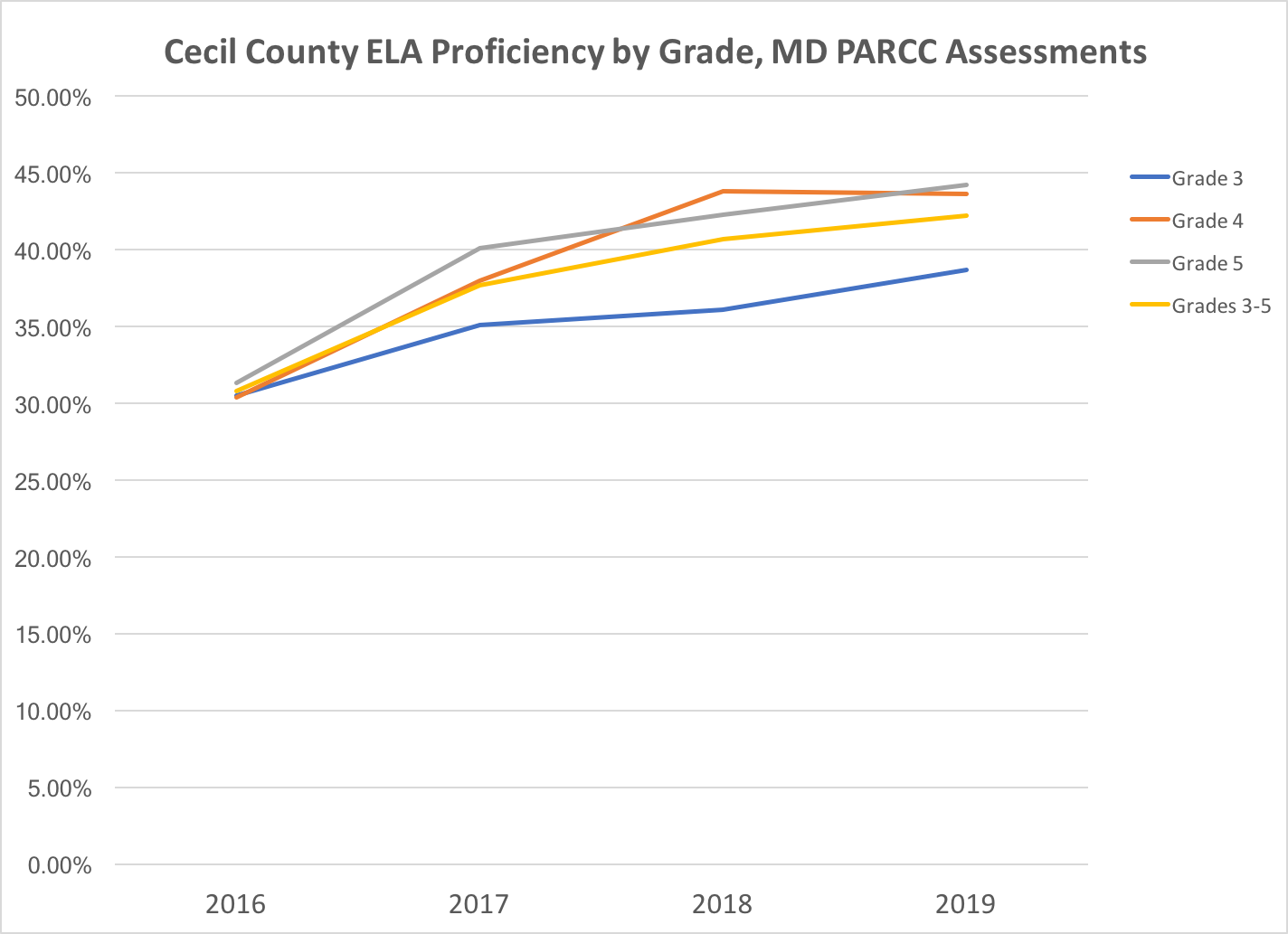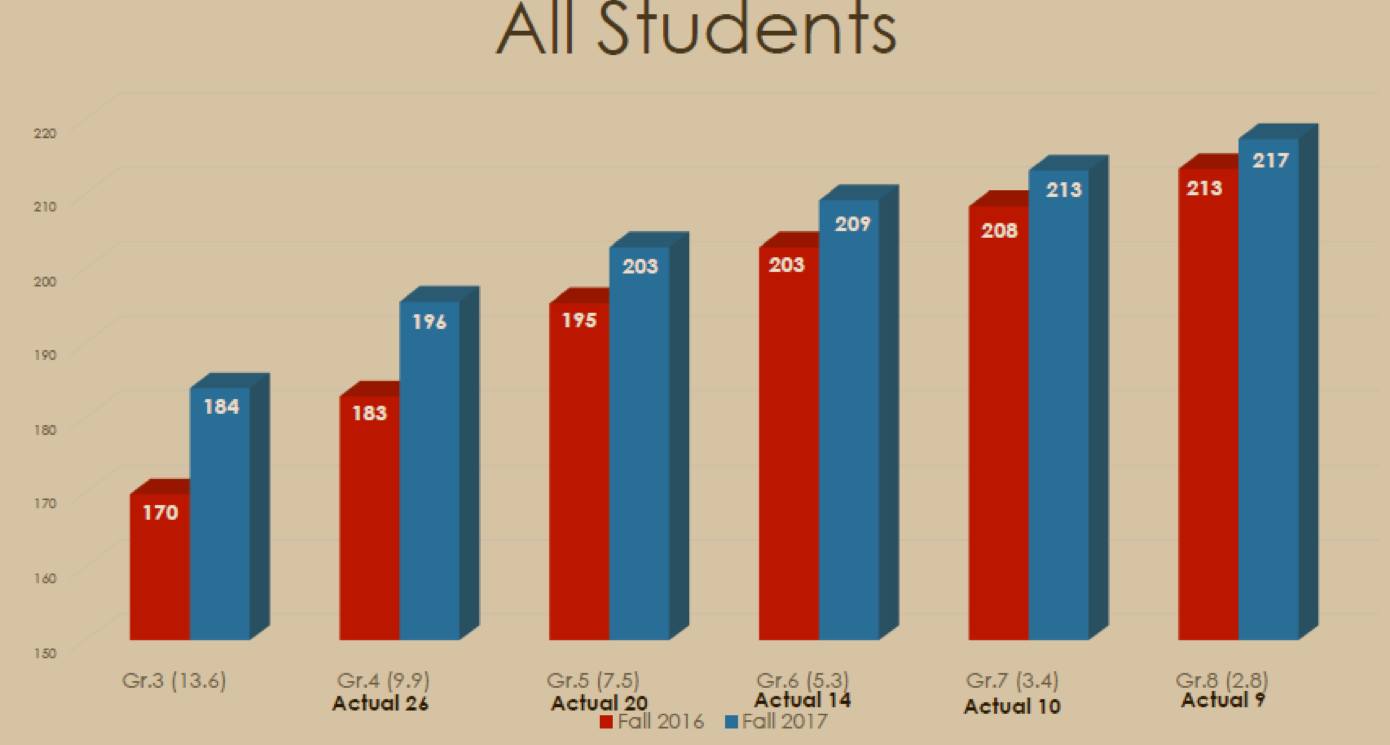Right now, we need to be sharing positive stories in K–12 education! That’s true because we’re going through a tough moment – and we don’t just mean the challenge of the coronavirus. Midway through this school year, the nation reflected on worrisome NAEP outcomes suggesting that literacy instruction needs work.
Once, Cecil County had a flawed approach to literacy – and weak outcomes. We think our turnaround story can add important and encouraging color to the conversation.
In our district, a focused effort to improve literacy outcomes paid off for students and for teachers. Jeff calls it the biggest win of his career! Yet it once felt like a gamble.
In 2016, we brought in a new curriculum called Bookworms, in order to align with key reading research. It puts a huge premium on work with authentic texts; kids read 205 authentic books between kindergarten and 5th grade during Tier 1 instruction!
Bookworms is a relatively ‘scripted’ program, but its daily routines are tightly optimized to develop skilled readers. Foundational skills are emphasized, and frequent assessment is paired with targeted differentiation resources, which has really accelerated student growth for our learners.
And boy, has this work paid off. In Cecil County:
1. Our reading outcomes went through the roof:
We were clearly underperforming in literacy before the change. Of 24 counties in Maryland, we are #16th for wealth, but our reading outcomes were near the bottom of the state.
After changing curricula, our proficiency growth went up 11.4% points between 2016 and 2019, which made us the fastest-improving county in Maryland on the PARCC assessment.

Our steady growth continued through this winter’s midyear assessments.
After the curriculum change, we noticed that our 4th graders performed higher than the previous year’s 5th graders in MAP testing, which is normed against millions of kids. We’ve seen drastic jumps in all sub-groups and in all grades.
Perhaps the most powerful outcome: our intervention program is shrinking! Today, we have very few children needing Tier 3 intervention for reading. Before, children were doomed to repeating the same intervention without making much improvement. Now our kids are moving and growing!
2. Our students are demonstrably more engaged with reading.
After we changed curriculum, our public libraries reported shortages of books with the authors and themes studied in Bookworms! The library asked for our text list, in order to expand its collection in these areas to meet the growing demand.
3. We empowered our teachers as instructional leaders.
Our teachers say they have become actual teachers of reading because of Bookworms, which is so carefully aligned with reading research that it has an “educative” effect. Teachers can’t help but learn excellent practices in the initial years of using the materials. Their comfort with foundational skills is far higher, for example.
4. We gained a culture of collaboration.
When the curriculum was Do It Yourself, teachers were on different pages… literally.
Using a common curriculum created a systemwide Professional Learning Community. Our teachers now have a common language and understanding. In meetings, they no longer simply share out what they are doing in class – instead, teachers actually have substantive conversations about student work.
5. We improved equity.
Our previous “hodge podge” approach to curriculum resulted in significant discrepancies in instruction classroom to classroom. We’ve nipped that in the bud.
6. We saved money.
We saved around $1M per year by using Bookworms instead of Journeys or Wonders, the other programs we considered. Best of all, a significant portion of our investment goes to PD each year. We’re investing more in teachers.
As district leaders, we aren’t the only ones thrilled with the outcomes. In surveys, 80% of our teachers give this new curriculum a thumbs up.
Does this all sound too good to be true? It shouldn’t. These gains didn’t come easy, so we’ll share the journey – including its challenges.
Jeff was Associate Superintendent of Academics when our 2016 PARCC scores showed 30% proficiency. It simply wasn’t good enough. He’d been a high school math teacher, and didn’t have strong opinions about how reading should be taught. Jeff simply wanted improvement, and when the Bookworms curriculum was recommended through University of Delaware contacts, it sounded promising.
Yet at the time, guided reading was nothing short of gospel in Cecil County. In retrospect, we can see that we were not really teaching reading: we were good at getting kids to read in their comfort zone, but not always delivering instruction that would grow students as readers. Also, guided reading was keeping many kids trapped in low-level texts.
We had to make a serious mindset shift to implement Bookworms. That mindset shift started with Cathy, a long time believer in guided reading. Once she began learning reading research behind Bookworms, she was stunned at how much she hadn’t known, and ready to lead a change.
Some folks plan a phased rollout of new curriculum, but our implementation approach was “all in.” We went whole hog with a districtwide implementation of Bookworms in the 2016-17 school year. In the process, we asked folks to take a leap of faith. We provided PD on the materials and how to use them, but we saved a lot of the PD on the reading research behind the curriculum for year two. Our thinking was: when you’re asking teachers to change practice, sometimes you have to go ahead and change practice, and the change in beliefs follows when teachers see students respond… which is what ultimately happened.
We had growing pains in the first 4-6 months. Teachers were concerned about pacing; some struggled to get through 45-minute lessons in 45 minutes. The culprit: they were over scaffolding, unpacking texts so much before reading that students almost didn’t need to read them! Teachers learned to dial back the pre-teaching and allow students to learn from the text itself, which is a beautiful thing.
Teachers also had fears: Did the curriculum go too fast for struggling kids? Was the text complexity simply too high for our lowest learners? Was it taking away teacher autonomy?
We needed to work through those fears, and that meant a lot of time in schools in that first year, logging listening time. Sometimes you just need to let people vent. And while you’re being proactive with support, you also need to hear – and react to – the issues you didn’t anticipate.
The fears began to dissipate as soon as teachers saw growth in DIBELs and MAP testing. We knew things were on track when teachers said, “I’ve never seen my kindergarten students reading so well so early in the year.” Now, two years later, we hear NONE of the initial concerns about this work. It’s amazing what schoolwide reading improvement does to motivate a team.
We embraced two key things in order to foster success:
First, grace and space for teachers. In Year 1, we told building leaders to stay out of classrooms at the beginning. We didn’t think they knew the curriculum well enough to know what to look for and critique, and teachers deserved time to get their feet wet before being evaluated, even informally. We gave everyone time to come up the learning curve.
Second, flexibility. We had to alter the school day for Bookworms, which has a firm requirement of 2 hours and 15 minutes of instructional time. We also allowed teams to departmentalize, because we were implementing math curriculum at the same time, and this allowed all teachers to focus on one change, rather than two.
But the ultimate success factor was the quality of the curriculum. Perhaps this is stating the obvious, but our positive story only came together because the curriculum quickly drove up our outcomes, leading to buy-in. Evidence-based curriculum works – implemented well, of course.
Seeing our outcomes, some might wonder why everyone isn’t doing this work. So… why do other districts persist with weak reading programs – or even try high-quality curriculum and bail on it? Some district leaders aren’t ready for the hard conversations. It’s difficult to ask teachers to put practice ahead of beliefs, and leaders need to be ready to work through doubts and fears. In addition, we have seen districts attempt curriculum pilots in which a small number of naysayers create resistance to change. It’s one reason that we recommend the just-go-whole-hog approach.
Our advice to district leaders: this is a risk worth taking, with a payback that is greater than we could have imagined.
Dr. Jeffrey Lawson is the Superintendent and Dr. Cathy Nacrelli is the Elementary ELA Supervisor in Cecil County Public Schools (MD). They can be reached at jalawson@ccps.org and cnacrelli@ccps.org.
A Note on the Distance Learning Era
You might wonder how we are experiencing distance learning while using Bookworms. We’ve enjoyed the reflections on this topic from teachers in Baltimore and district leaders in Tennessee.
Although we didn’t use the Bookworms curriculum in our recent “at home learning” materials (because students didn’t have access to the books at home), we certainly used the Bookworms routines, and we relied on our Bookworms-inspired learnings about good reading instruction, to craft lessons that:
- Provide quality grade level texts, fiction and nonfiction, for all students
- Incorporate reading and then rereading opportunities in our “at home” lesson plans
- Utilize questions that help students identify and discuss text structures
- Focus discussion questions on grade level standards
- Incorporate discussion and sharing of ideas around fiction and nonfiction texts
- Interact with text rather than completing isolated grammar worksheets
- Read and write about what you’ve read
- And READ some more!
People talk about the “educative value” of high-quality curriculum, and this is something we have experienced, as well. We know what good looks like, so our team is better prepared to create lessons for this unique challenge, with focus on the right instructional priorities.
When we think about our “hodge podge” curriculum era, and what distance learning would have looked like if every teacher was tasked with DIY Distance Learning, we are even more convinced that our curriculum investment has been essential to our efforts to provide strong instruction to all students.

